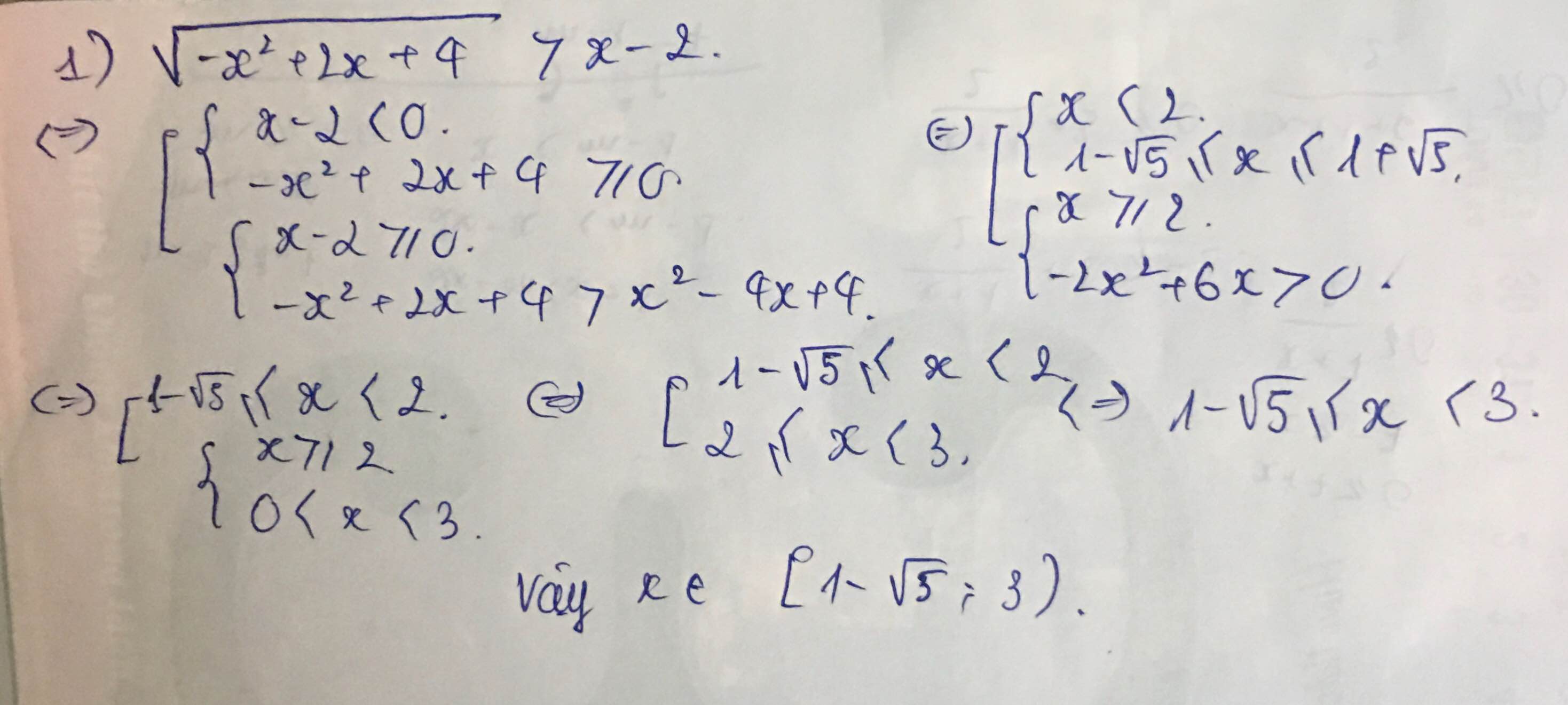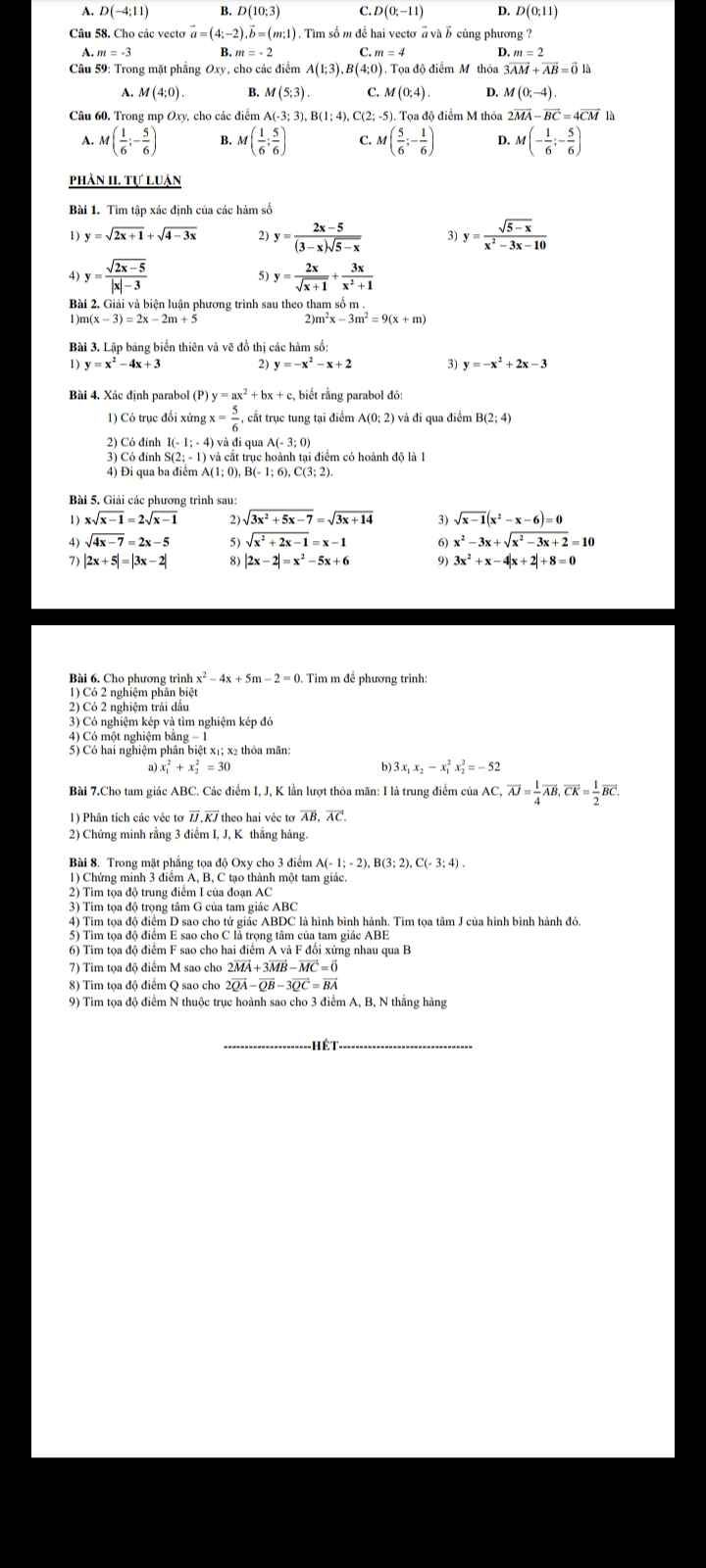Hãy nhập câu hỏi của bạn vào đây, nếu là tài khoản VIP, bạn sẽ được ưu tiên trả lời.

ĐK: \(x\ge0\)
Dễ thấy \(1-\sqrt{2\left(x^2-x+1\right)}\le1-\sqrt{2}< 0\)
Khi đó bất phương trình tương đương:
\(x-\sqrt{x}\le1-\sqrt{2\left(x^2-x+1\right)}\)
\(\Leftrightarrow\sqrt{x}-\dfrac{1}{\sqrt{x}}-1+\sqrt{2\left(x+\dfrac{1}{x}-1\right)}\le0\)
\(\Leftrightarrow\sqrt{x}-\dfrac{1}{\sqrt{x}}-1+\sqrt{2\left(\sqrt{x}-\dfrac{1}{\sqrt{x}}\right)^2+2}\le0\)
\(\Leftrightarrow t-1+\sqrt{2t^2+2}\le0\)

ĐKXĐ: \(x\ge1\)
Đặt \(\left\{{}\begin{matrix}\sqrt[]{x-1}=a\ge0\\\sqrt[3]{2-x}=b\end{matrix}\right.\) \(\Rightarrow a^2+b^3=1\)
Ta được hệ:
\(\left\{{}\begin{matrix}a+b=1\\a^2+b^3=1\end{matrix}\right.\) \(\Leftrightarrow\left\{{}\begin{matrix}b=1-a\\a^2+b^3=1\end{matrix}\right.\)
\(\Rightarrow a^2+\left(1-a\right)^3=1\)
\(\Leftrightarrow a^3-4a^2+3a=0\)
\(\Leftrightarrow a\left(a-1\right)\left(a-3\right)=0\)
\(\Rightarrow\left[{}\begin{matrix}a=0\\a=1\\a=3\end{matrix}\right.\) \(\Rightarrow\left[{}\begin{matrix}\sqrt[]{x-1}=0\\\sqrt[]{x-1}=1\\\sqrt[]{x-1}=3\end{matrix}\right.\)
\(\Rightarrow\left[{}\begin{matrix}x=1\\x=2\\x=10\end{matrix}\right.\)

ĐKXĐ: \(0\le x\le9\)
Bình phương 2 vế ta được:
\(x+9-x+2\sqrt{x\left(9-x\right)}=-x^2+9x+9\)
\(\Leftrightarrow-x^2+9x-2\sqrt{-x^2+9x}=0\)
\(\Leftrightarrow\sqrt{-x^2+9x}\left(\sqrt{-x^2+9x}-2\right)=0\)
\(\Leftrightarrow\left[{}\begin{matrix}\sqrt{-x^2+9x}=0\\\sqrt{-x^2+9x}=2\end{matrix}\right.\)
\(\Leftrightarrow\left[{}\begin{matrix}-x^2+9x=0\\-x^2+9x-4=0\end{matrix}\right.\)
Tới đây em tự hoàn thành nốt

a: Để phương trình có nghiệm duy nhất thì \(\left(m-3\right)\left(m+2\right)< >0\)
hay \(m\notin\left\{3;-2\right\}\)
Để phương trình vô nghiệm thì \(\left\{{}\begin{matrix}\left(m-3\right)\left(m+2\right)=0\\\left(m-3\right)\left(m-1\right)< >0\end{matrix}\right.\Leftrightarrow m=-2\)
Để phương trình có vô số nghiệm thì m=3

b: =>cos3x=(3m-1)/2
Để phương trình có nghiệm thì -1<=(3m-1)/2<=1
=>-2<=3m-1<=2
=>-1<=3m<=3
=>-1/3<=m<=1
a: 2*sin2x*cos3x-sin5x=0
=>2*1/2*(sin5x+sin(-x))-sin5x=0
=>sin(-x)=0
=>sin x=0
=>x=kpi




\(\left\{{}\begin{matrix}A+G=50\%\\\dfrac{A}{G}=0,6\end{matrix}\right.\)
\(\Leftrightarrow\left\{{}\begin{matrix}A+G=0,5\\\dfrac{A}{G}=0,6\end{matrix}\right.\)
\(\Leftrightarrow\left\{{}\begin{matrix}A+G=0,5\\A=0,6G\end{matrix}\right.\)
Thay \(A=0,6G\) vào ta có:
\(\Leftrightarrow\left\{{}\begin{matrix}0,6G+G=0,5\\A=0,6G\end{matrix}\right.\)
\(\Leftrightarrow\left\{{}\begin{matrix}1,6G=0,5\\A=0,6G\end{matrix}\right.\)
\(\Leftrightarrow\left\{{}\begin{matrix}G=\dfrac{0,5}{1,6}\\A=0,6G\end{matrix}\right.\)
\(\Leftrightarrow\left\{{}\begin{matrix}G=0,3125\\A=0,6\cdot0,3125\end{matrix}\right.\)
\(\Leftrightarrow\left\{{}\begin{matrix}G=0,3125\\A=0,1875\end{matrix}\right.\)
Vậy: \(\left\{{}\begin{matrix}G=31,25\%\\A=18,75\%\end{matrix}\right.\)
cho mik hỏi tại sao 0,6G + G= 1,6G vậy